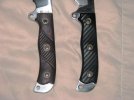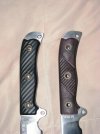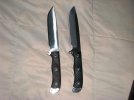TurnerIII
Gold Member
- Joined
- Jul 20, 2005
- Messages
- 5,871
Ok - my poor old head is confused ( I think is has more to do with not drinking for like 25 years than anything..) Regardless - I am in need of assistance and my question is....
Could someone please explain to me the difference between G10 and Black Paper?
I thought G10 was more like a plastic (I know - bad comparison but sort of like plastic?)- it has clear sharper corners and definitions And Black Paper has more texture and fibers (again not the best description - but a general concept) and more organic like ....
Pics would help show this to me -
Thanks in advance :thumbup:
:thumbup:
Could someone please explain to me the difference between G10 and Black Paper?
I thought G10 was more like a plastic (I know - bad comparison but sort of like plastic?)- it has clear sharper corners and definitions And Black Paper has more texture and fibers (again not the best description - but a general concept) and more organic like ....
Pics would help show this to me -
Thanks in advance




